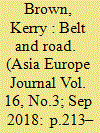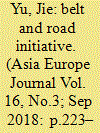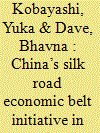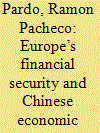|
|
|
Sort Order |
|
|
|
Items / Page
|
|
|
|
|
|
|
| Srl | Item |
| 1 |
ID:
160466


|
|
|
|
|
| Summary/Abstract |
We live in the era of storytelling and of leaders who are storytellers. That has always been the case. Max Weber argued that politicians are divided into sorcerers or warlords. With US President Trump, French President Macron, Russian President Putin, and above all with Chinese President Xi Jinping, we have people who might have access to plenty of assets of hard power, but who, aware of the cataclysmic risk of even appearing to deploy these, try to achieve their means by the magic power of stories.
|
|
|
|
|
|
|
|
|
|
|
|
|
|
|
|
| 2 |
ID:
160467


|
|
|
|
|
| Summary/Abstract |
This article explores the linkages between domestic affairs and foreign policies in China in fulfilling its grand ambition of Belt and Road Initiative (BRI). It examines the complexities in decision-making process of “BRI” inside Beijing’s administration. It departs from the most existing literature on BRI in Europe, which focus upon the geo-economic and geo-political impacts of the BRI. Instead, it adopts an “inside-out” approach by examining the actual policy process with a primary focus to individual actors such as the Party, the government department and the state-owned enterprises as well as individual academics. It also disentangles the intricate relations amongst the Party, the key decision-making institutions and the policy execution entities in determining the final outcome of the BRI. It will finally reflect the extent to which Beijing’s bureaucratic complexities have impacted upon the EU and its member states’ willingness in collaborating or in formally endorsing China’s BRI.
|
|
|
|
|
|
|
|
|
|
|
|
|
|
|
|
| 3 |
ID:
160470


|
|
|
|
|
| Summary/Abstract |
The Silk Road Economic Belt (SREB) initiative, launched by Xi Jinping in 2013 as the Central Asian component of the Eurasian Belt and Road Initiative (BRI), is presented as a trade and infrastructural developmental initiative that benefits all to deliver stability. It consolidates Beijing’s existing economic investments and security-building measures, while launching new projects to link the regions of Central Asia and South Asia more closely with China and extend the arc of security westward and develop these as a transport corridor linking China to Europe. This article examines the interaction between China’s infrastructural investments and security dynamics in the Central Asian region, exploring why the BRI/SREB, presented by China as primarily as a developmental vision, is fraught with wide-ranging security implications. We examine the reception of China’s BRI/SREB in Central Asia focusing on the following three dimensions: (1) the lure of Chinese investments which makes SREB particularly attractive for Central Asian countries; (2) the securitization thrust of the Silk Road initiative which consolidates the power of the Central Asian regimes but also grants considerable role to China in managing security arrangements; (3) elite maneuvering between the lure of Chinese investments and appeasing popular anxieties about China’s growing influence. It points to the overall positive reception in the region to the aid and investment offered by China, while noting the variance in their responses based on the implications of SREB for their sovereignty and security and also concerns on whether the promised benefits of connectivity and development (a “win-win” scenario) will materialize. The article concludes by outlining the implications of China’s rising economic and security engagement in Central Asia and the close Sino-Russian partnership for European financial and security interests and highlights the areas of cooperation and complementarity between China and EU in the region.
|
|
|
|
|
|
|
|
|
|
|
|
|
|
|
|
| 4 |
ID:
160469


|
|
|
|
|
| Summary/Abstract |
This paper examines energy cooperation within the Belt and Road Initiative (BRI) with reference to the European Union’s experience of the Trans-European Network for Energy (TEN-E) in addressing various policy challenges, including market competitiveness, climate change and the security of supply through energy infrastructure networks. As a development framework with strong geo-political and geo-economical dimensions, the BRI aims to promote interconnectivity and cooperation in infrastructure, policy, trade, finance and culture among Eurasian countries. The implementation of the BRI is expected to involve numerous investments as well as infrastructure construction and industrial integration in the energy sector. The EU experience in creating an energy network has indicated a clear synergy between infrastructure networks and the market. In the 1990s, TEN-E was developed to create an integrated energy market, reinforce economic and social cohesion, and connect peripheral regions. Through an analysis of the EU experience, this paper argues that the BRI foresees turning China’s energy cooperation in Eurasia into an integrated and multilateral strategy. While energy infrastructure networks could contribute to achieving the BRI’s objectives, possible obstacles exist in the creation of those networks in the BRI, including asymmetric policy priorities, financing challenges and the lack of a multilateral legal framework.
|
|
|
|
|
|
|
|
|
|
|
|
|
|
|
|
| 5 |
ID:
160468


|
|
|
|
|
| Summary/Abstract |
The core of the Belt and Road Initiative (BRI) involves trillions of US$ in investment to increase and improve connectivity between China and different parts of the world. This includes tens of billions of US$ to build or upgrade roads, rail lines, ports, pipelines and other infrastructure to connect China with Europe. With the European continent still feeling the effects of the Global Financial and Eurozone Sovereign Debt crises, this is an opportunity to strengthen its financial security by gaining access to a new source of financing. This new source, however, is linked to Chinese economic statecraft. Thus, cash-starved Europe can tap on the recently launched Silk Road Fund, Maritime Silk Road Fund and other initiatives from the Chinese government. Concurrently, however, political divisions within Europe derived from Chinese investment, as well as normative differences in terms of standards and practices present a challenge to the continent. This article thus analyses the effects of BRI, presented as a tool of Chinese economic statecraft, on Europe’s financial security. It argues that in spite of the latent challenges to said security, the potential benefits have already led many European countries to seek to tap on BRI’s investment as a means to strengthen their financing position.
|
|
|
|
|
|
|
|
|
|
|
|
|
|
|
|
| 6 |
ID:
160471


|
|
|
|
|
| Summary/Abstract |
In view of the resources invested by China in the Belt and Road Initiative (BRI) and the geopolitical-security dynamics at play, it is helpful to examine the notable security risks and uncertainties of the project. Embedded in this broad context, the paper at hand zooms in on one of the world’s most volatile regions—the Middle East, situated strategically at the juncture of the overland and seaborne routes. Substantively, it focuses on the security dynamics in the region and China’s current engagement therein, with a view to assessing whether and the extent to which China will boost its strategic presence in the BRI context. Some conclusions can be drawn from the research. First, the Middle East faces a multiplicity of security risks and challenges, compounded by a problematic existing security architecture based on inadequate cooperation among regional actors and questionable ad hoc interventions by major outside powers. Second, China’s current relations in Middle Eastern countries have been overwhelmingly economic and driven by energy. Its political-security presence, albeit growing, remains marginal. Third, given the imperatives for China to play a more substantial role in Middle Eastern security (not least the need to ensure the BRI’s security) and the risks/costs of doing so, it would make sense that China seeks to step up its game in areas that are conductive to stabilising the region and yet do not entail intensively investing strategic resources and publicly taking sides (e.g. infrastructure and conflict mediation). This offers reasonable prospect of further EU-China cooperation.
|
|
|
|
|
|
|
|
|
|
|
|
|
|
|
|
|
|
|
|
|